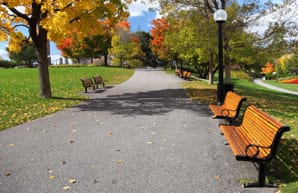Prior research would suggest that parks are an important element of a livable life. Evidence has connected physical activity, psychological restoration, and social health to proximity to parks and sites of recreation. This research, however, is primarily based on samples of university students and western European populations who are financially comfortable. Research on proximity to public parks and health disparities in low-income St. Louis neighborhoods, however, find no evidence of any association between park proximity and positive measures of health. In fact, new research conducted by Brown School Assistant Professor Aaron Hipp finds that even neighborhoods with close proximity to large public parks have high health disparities.
A grant from the Livable Lives Initiative offered Hipp an opportunity to investigate this unexpected finding. The university-wide Livable Lives Initiative investigates what social conditions and policy supports can make life with a low or moderate income stable, secure, satisfying, and successful. Eight research grants were awarded in 2009 to Washington University faculty interested in pursuing innovative research that would inform local programs as well as state and federal policies in economic security, employment, public health, education, housing, and other key areas.
With a Livable Lives grant, Hipp undertook research on St. Louis area residents’ relationship to publically-funded parks in two low-income, predominately African American neighborhoods with high health disparities. Both neighborhoods had access to parks of over 125 acres in size—O’Fallon Park in St. Louis city and St. Vincent Park in St. Louis county.
Both parks were underused, and Hipp convened several focus groups to identify barriers to park use in these neighborhoods. A number of barriers were mentioned by focus group participants, including concerns about safety, lack of seating, and poor maintenance. Teens, who reported no outdoor time at their high school and no physical activity time aside from organized sports, expressed limited interest in visiting the park.
“It seems clear that, at least in these neighborhoods in St. Louis, proximity to a park alone is not enough to ensure associated improvements in health and well-being,” says Hipp. “The park is there, but we have to figure out how to get people to use it. Is it programming that draws people? Is it park amenities? Is it changing the historical perception of crime in the parks?”
Following the completion of the Livable Lives project, a development at one of these parks presented a natural opportunity for Hipp to continue his research. O’Fallon Park received a significant makeover in 2010, including the creation of a new jogging track, playground equipment, basketball courts, and the renovation of the park’s boathouse. A free, weekly concert series held that summer drew crowds of up to 400 people.
“It was a natural experiment,” says Hipp. “Would these improvements increase regular use of the park by local residents?”
With help from the community, Hipp convened another set of focus groups approximately 3-4 months after the renovations had been completed. Although there was little evidence of increased park use, focus group participants expressed optimism about the park’s potential to contribute to neighborhood health and well-being.
Construction of a recreation center at O’Fallon Park has begun, and will provide further opportunities for follow-up research.
“Although it’s heartening that neighborhood residents are expressing optimism, it is still unclear what aspects of park design promote park usage. If residents have not been in the habit of visiting the park, it may be that programming is also needed to encourage park use,” says Hipp.
Meanwhile, Hipp is considering other research approaches that may get at what factors promote use of public parks and are associated with lower health disparities in St. Louis. He has begun using GIS mapping to measure the association of park amenities with health disparities in nearby neighborhoods. Findings from this data are not yet available.
“We need to find better measures of park quality,” says Hipp. “We hope this research will help us zero in on what attracts local residents to parks. That knowledge will help us increase opportunities for people in the St. Louis area to enjoy the associated health benefits of park use.”
According to Michael Sherraden, Benjamin E. Youngdahl Professor of Social Development and one of the leaders of the Initiative, Hipp’s ongoing research is a perfect example of the innovative, long-term research Livable Lives hoped to spark.
“Livable Lives aims to move forward the thinking, research, advocacy, and policy associated with achieving livable lives,” says Sherraden. “We were hopeful that these grants could encourage innovative research that would continue and grow long after the grant’s end. Aaron’s project has done just that.”
The Livable Lives Initiative will hold its first conference on February 27-28, 2012, focusing on employment and economic security. The two day conference will feature a keynote speech by Jared Bernstein, Senior Fellow at the Center on Budget and Policy Priorities and former Chief Economist and Economic Policy Adviser to Vice President Joseph Biden and will also include panels on household financial fragility, employment policy, and health policy and employment.
The conference is sponsored by the Center for Social Development, the Center for the Interdisciplinary Study of Work and Social Capital, the Center for New Institutional Social Sciences, the Weidenbaum Center on the Economy, Government, and Public Policy, the American Culture Studies department in Arts & Sciences; and the Office of the Provost. The conference is held in partnership with the Brown School Policy Forum at Washington University and the New America Foundation in Washington, DC.
